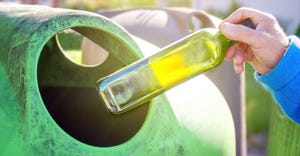How Recyclable is Foodservice Packaging?
The bulk of these products are wasted because municipalities don’t realize they are recyclable.
Recycling the durable materials used for foodservice packaging into new fiber sources represents an untapped potential market, say manufacturers in the space.
The bulk of these products are wasted because municipalities don’t realize they are recyclable, says Lynn Dyer, president of the Foodservice Packaging Institute (FPI). Yet most material recovery facilities (MRFs) accept it when it’s sent their way, according to a 2013 study of 62 U.S. and Canadian MRFs. Overall, 75 percent of MRFs surveyed accepted 10 or more of the 19 types of FSP included in the study.
Many of the items could be sorted by category, such as “prepicked plastics 3-7,” and placed in mixed bales. Foam polystyrene cups and containers can be densified and recovered in a separate bale or sometimes also as prepicked 3-7 bales, where there is infrastructure.
“There is a misconception that MRFs and end markets don’t want foodservice packing because it is too food contaminated,” Dyer says. “But our studies found it’s no more contaminated than regular food packaging that is being recycled. So, we are having conversations to clear this up.”
The FPI’s focus has been on residential curbside collections as most of the disposable products end up in homes.
“In homes the food is gone or the packaging is rinsed, so we found in two studies almost no difference between food residue on foodservice packaging and other food packaging like peanut butter jars [or most of what is sold in grocery stores],” says Dyer.
The most accepted items were cup sleeves, pizza boxes and paper carry-out bags. Next came rigid plastic items like plastic cups and containers. The least accepted items were beverage carriers, containers and egg cartons made from coated paper, molded pulp and/or polystyrene foam.
Based on what MRFs and end markets can deal with, the FPI is asking communities to add packaging to their curbside programs and is developing tools to help them do it.
Washington, D.C., just became one of the latest municipalities to focus on recovering these materials. Residents and businesses will be required to recycle a list of paper and plastic plates, cups, lids, trays and other items, beginning in 2018.
The FPI is working go get more cities on board. It provides information on its website for MRFs. Last month it also added a community section with a downloadable flyer template along with images of materials. Cities can use these tools to communicate clearly with constituents as programs are rolled out.
The organization is also offering other kinds of assistance.
“For instance, we are talking to paper mills to be sure they can accept paper cups from MRFs,” Dyer says. “Then we will ask communities to take those cups and we’ll work with them on educating residents. We are willing to be a touch point and connect the dots as far as making sure all the players, their understanding, and capabilities are aligned.”
Atlanta-based Georgia-Pacific (GP) manufactures foodservice packaging made from both recycled and virgin materials. The company has four U.S. paper mills that use recycled paper.
“Foodservice packaging recycling is in single digits. But it has good fiber, so we are wanting to get it in a condition to compete with other [papers.] We are working with FPI and its members to see how we can increase recovery levels,” says John Mulcahy, vice president of sustainability for Georgia-Pacific consumer products.
The focus for now is primarily on residential programs because that’s where most of the material is and where it’s easiest to recover, he says.
“If we can show a win there, that will give the effort credibility to move to the next value opportunity, which would be businesses,” Mulcahy says.
Georgia-Pacific is looking at technologies to invest in at its own facilities to be able to dig deeper into the waste stream. Already the company is able to process dirty paper streams cost efficiently, says Mulcahy, but he believes there is more potential.
“New technologies could be developed to deal with materials with polyethylene on both sides,” he says. “It takes longer to separate plastic coating from the paper, but we are trying to find ways to do it.
“We are looking to invest for our company to get an advantage in the market place and to provide more materials others can use.”
About the Author
You May Also Like




